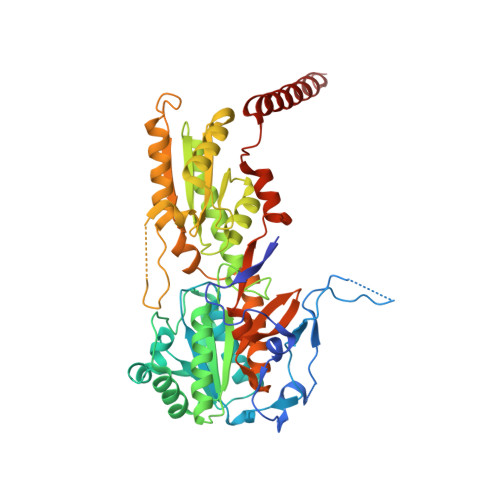The crystal structure of ATP-bound phosphofructokinase from Trypanosoma brucei reveals conformational transitions different from those of other phosphofructokinases.
McNae, I.W., Martinez-Oyanedel, J., Keillor, J.W., Michels, P.A., Fothergill-Gilmore, L.A., Walkinshaw, M.D.(2009) J Mol Biol 385: 1519-1533
- PubMed: 19084537
- DOI: https://doi.org/10.1016/j.jmb.2008.11.047
- Primary Citation of Related Structures:
3F5M - PubMed Abstract:
The crystal structure of the ATP-bound form of the tetrameric phosphofructokinase (PFK) from Trypanosoma brucei enables detailed comparisons to be made with the structures of the apoenzyme form of the same enzyme, as well as with those of bacterial ATP-dependent and PP(i)-dependent PFKs. The active site of T. brucei PFK (which is strictly ATP-dependent but belongs to the PP(i)-dependent family by sequence similarities) is a chimera of the two types of PFK. In particular, the active site of T. brucei PFK possesses amino acid residues and structural features characteristic of both types of PFK. Conformational changes upon ATP binding are observed that include the opening of the active site to accommodate the two substrates, MgATP and fructose 6-phosphate, and a dramatic ordering of the C-terminal helices, which act like reaching arms to hold the tetramer together. These conformational transitions are fundamentally different from those of other ATP-dependent PFKs. The substantial differences in structure and mechanism of T. brucei PFK compared with bacterial and mammalian PFKs give optimism for the discovery of species-specific drugs for the treatment of diseases caused by protist parasites of the trypanosomatid family.
Organizational Affiliation:
Structural Biochemistry Group, Institute of Structural and Molecular Biology, University of Edinburgh, King's Buildings, Edinburgh, Scotland.



















